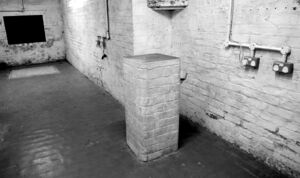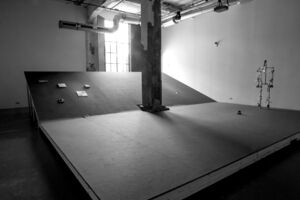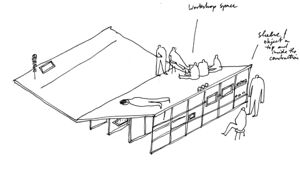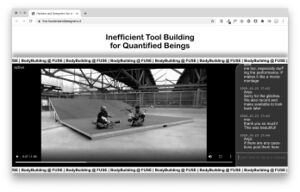Publishing:Making Matters Lexicon: Difference between revisions
No edit summary |
No edit summary |
||
| Line 1: | Line 1: | ||
=bodies= | =bodies= | ||
{{ | {{:Embeddedness}} | ||
{{/Hosting}} | {{/Hosting}} | ||
Revision as of 13:28, 10 February 2022
bodies
embeddedness
In assembling ideas that are seemingly disconnected and uneven (the seabird and the epilogue, the song and the soil, the punch clock and the ecosystem, the streetlight
and the kick-on-beat), the logic
of knowing-to-prove is unsustainable because incongruity appears to be
offering atypical thinking.
Yet curiosity thrives.[2]
embeddedness:
to be set solidly into a mass
Ship merchants operating from the Liverpool docks in the nineteenth century needed the tides predicted and their clocks calibrated, so they commissioned the Bidston Observatory. The observatory was to be strategically situated on the highest point of the Wirral peninsula, overlooking the river Mersey, the river Dee, and the Irish sea. Completed in 1866, it was made out of sandstone extracted from the bedrock below, creating a cavity which now forms the observatories’ extensive basements.[3] Around the building, a deep moat was dug to minimize interference from neighbouring traffic. The plinth in the picture (p. 30) is a ‘bedrock connection point’, located in the observatory sub-vault. Sheltered from temperature shifts and movements from elsewhere, the plinth provided a stable platform for a century of exacting earth observation.
Cornwall, last fall. Suddenly they feel the ground tremble, and hear windows rattle. Afterwards, Dr. Ryan Law, managing director of Geothermal Engineering explains to the local press:
As part of the United Downs Deep Geothermal Power testing, we did cause some micro-seismicity. Although this was within our regulatory limits,
we are stopping operations until we understand the cause. The tremors are low-scale and should not be anything to be afraid of.[4]
Geothermal energy is produced by harnessing heat from the earth’s core. To produce power from this heat, extremely deep wells need to be drilled and water is pumped through them at high pressure. Since the Bronze age, Cornwall has been mined for tin, copper, arsenic, and lithium. Tremors in the porous underground are set off as a result of the additional disturbance caused by geothermal boring. In the non-committal words of the general manager, they sense all the troubles that wreck the earth: ‘we caused micro-seismicity’ ... ‘within our regulatory limits’ ... ‘until we understand the cause’ ... ‘not anything to be afraid of’.
embeddedness:
laying in a bed of surrounding matter
South or north of here, already more than ten years ago. It takes him many long days to level the driveway of his holiday home. Using a barre à mine, a forged iron bar originally used by miners to pound the ground and break the surface, his movements reverberate through the valley. Eventually, he hits an immovable piece of rock and the pounding stops. He points, almost proudly, and says: ‘look, the earth!’
Early on, the observatory installed a seismometer on the sub-vault plinth. Kept in the dark, it continuously auto-registered slight movements on light sensitive paper that corresponded with earthquakes experienced on the other side of the planet. A Milne-Shaw Vertical Tiltmeter was acquired in 1910, a precision instrument based on the same principle as the seismograph, where one part remains stationary and fixed, while another part moves together with the earth’s surface. The vertical tiltmeter derives its precision from using a rigid arm that points upwards, with a pendulum hanging down from it. The swinging of the pendulum, with its fulcrum fixed to the bedrock connection point, makes micro-seismicity observable by magnifying the actual motion of the earth. It was with this instrument that the phenomena of ‘tidal load’ could be observed, the oscillating north-south tilt of the Wirral peninsula due to the strain of the water weighing down the bedrock (and subsequently, the plinth itself) at high tide.
A physiotherapist once told me about her interest in how bodies feel their way around with the help of instruments. She explained her fascination through the example of cooking a soup or a sauce. If you stir the bottom with a wooden spoon, she said, you will feel precisely at which moment it starts to catch. You do not need to put your hand into the hot liquid to touch the bottom of the pan.
At the observatory, the so-called ‘ocean loading effect’ continued to be registered with increased precision until the early seventies, when the expanding data about earth tides from around the world started to show unexplained discrepancies in neighbouring sites; the magnitude of the north-south tilt varied by twenty percent when measured in one end of its sub-vault, or the other. In an article called ‘Tidal Tilt Anomalies’, two scientists working at Bidston claimed that these inconsistencies could be explained by unknowable couplings between the landmass movement and the strain on the site itself. ‘A mine or a tunnel, in which tilt measurements are usually taken, represents a discontinuity in the Earth’s crust.’[5] By comparing different types of instruments, they found that tiltmeters were extremely accurate but that they were measuring tidal tilt in combination with hyper local movements due to situated geological conditions. Tidal tilt observations where eventually abandoned due to non-compliant embedded data.
embeddedness:
trembling with the earth
As with many material evidences of techno-scientific progress, the appointing of stability, the fixing of a point zero wherever convenient, seems to require an entitled mode of being in the world.
Each point is merely a conceptual marker, which can be assigned and reassigned in the equation hierarchy as the ‘coordinating zero point’ and every line can be formed to be the ‘coordinating axis’.[6]
Power arranges itself around such arbitrary vantage points, through which the movement of goods and people elsewhere can be controlled. Contributing to the reliable navigation of ships across the British empire, but also actively and continuously supporting the convenient fable of transparent observation, the Bidston Observatory aligned with different scales of capitalist endeavour, exploitation, colonialist and imperialist modes of worlding.[7]
He is being driven around his native island Martinique, pointing out the places that he grew up in and that vanished after the earthquakes. The island is part of an archipelago located on the crumbling intersection of two tectonic plates, which makes the geo-plasticity of the earth regularly interact with human activity. ‘We understand the world better if we tremble with it’, he explains.[8]
To be embedded depends politically nor epistemologically on a fixed locus of observation. It opposes systematic thinking without fear, because it is a mode of understanding the world that resonates with the multidimensional and multidirectional impact of being embedded, of its inherent instability. Embeddedness is to ‘tremble with the world’.
The image cuts back to the view from the car window, an undulating green landscape moving by under a bright blue sky filled with clouds. He continues:
The world trembles in every way. It trembles organically and geologically. It trembles even with the climate, poor me, as far
as I know. But the world also trembles through the relations
we have with each other.[9]
- ↑ This contribution is based on the script for a performative introduction to the sub-vault of the Bidston Observatory Artistic Research Centre (BOARC) for participants of the work session Down Dwars Delà, organized by Constant and BOARC, Liverpool, August 2021, constantvzw.org/site/Open-call-study-session-Down-Dwars-Dela-2-UK.
- ↑ Katherine McKitttrick, Dear Science and Other Stories (Durham: Duke University Press, 2021), p. 4.
- ↑ The Bidston Observatory was built on the solid bedrock of the Wirral peninsula, ‘a capping of Keuper sandstone on soft Upper Bunter’, which was considered to be more stable than other geological arrangements elsewhere. Joyce Scoffield, Bidston Observatory: The Place and the People (Merseyside: Countyvise Ltd, 2006).
- ↑ Sabi Phagura, ‘Houses shake as Cornwall is rocked by FIFTEEN “earthquakes” measuring up to 1.5 in magnitude in two days caused by tests at geothermal drilling site’, Daily Mail, 1 October 2020, dailymail.co.uk/news/article-8794885/Houses-shake-Cornwall-rocked-15-earthquakes-two-days.html.
- ↑ T.F. Baker and G.W. Lennon, ‘Tidal Tilt Anomalies’, Nature 243 (1973), pp. 75–76.
- ↑ Clancy Wilmott, Mobile Mapping Space: Cartography and the Digital (Amsterdam: Amsterdam University Press, 2020).
- ↑ ‘The Center is Open/HECS is ajar!’, wiki.bidstonobservatory.org/index.php/About.
- ↑ Manthia Diawara, ‘One World in Relation: Édouard Glissant in Conversation with Manthia Diawara’, NKA Journal of Contemporary African Art 28 (Spring 2011), pp. 4–19.
- ↑ Ibid.
Publishing:Making Matters Lexicon/Hosting
collective
platform
a platform design request
In recent years the Hackers & Designers collective[1]
has been frequently approached by organizations and initiatives from the fields of art, design, technology, and academia with the question: ‘Do you want to design our platform?’ An intricate question as the term platform refers to a multitude of phenomena and objects. The platform’s ambiguity seems particularly amplified when articulated as part of a design brief, suggesting that the platform is to be an expansion of the realm of designed things.
An organization as platform supports individuals or groups in addressing an audience. In a computational context, the term platform refers to a technical infrastructure, for instance an environment in which software applications are designed, deployed, or used, such as computer hardware, operating systems, gaming devices, mobile devices.[2]
With the H&D collective we have designed, built, and maintained technical infrastructures, such as software, webware, and services that enable online collaboration, production, organization, and publishing of digital content. Such diy platforms are tool convergences that—in their particular composition—cater to the particular needs of the collective. They are content management systems,[3] chat applications,[4] collaborative writing tools,[5] online spreadsheets[6] and file sharing systems.[7] These self-made, appropriated or hacked tools and systems are implicated in the ways the members of the collective work together. H&D’s technical infrastructure continuously evolves, and at times fails, or acts in an unexpected way. H&D shapes and reshapes its modes of organizing around the possibilities and limitations of such self-made platforms—along with learning to cope with system incompatibilities, broken links, expired protocols, and unreliable backups. Therefore, the notion of platform is at the core of its existence.
The platform-design request implies that a platform can be regarded as separate from its context, and that there is a causal relationship between platform and design. However, because of how the H&D collective has developed relationships with technical infrastructures
it would be difficult to disconnect the technical aspects from the organizational and social aspects of platforms. The question then arises whether platforms—in the way
we relate to them at H&D, as an inherent part of the collective’s fabric, including its characteristic of constant emergence, spontaneity, and unreliability—
can be designed at all?
In my view, the question: ‘Do you want to design
our platform?’ wrongly implies a certain fixedness,
a beginning and an end of a digital platform
and the possibility to foresee a platform’s trajectory.
The ‘commissioners’ who formulated the request position themselves as end users of the platform, and suggest some kind of ownership of it. It would be ‘their’ platform that ‘we’ are designing. However, a platform, as I see it, in its manifold of meanings is interwoven in collective practice and cannot be owned.
thinking with platforms
Besides its technical connotations, the term platform is also often used figuratively, for instance referring to organizations such as H&D. As such, it tends to assign an assumed value to the platform-organization as supportive and enabling, and risks a flattening of the technical and organizational particularities and implications of a collective. The question is how to think with the various meanings of ‘platform’? How do platform’s different (technical, organizational, architectural, political) connotations intersect—act together and apart?
In 2020, H&D developed a physical structure,[8] the ‘H&D platform’, together with architectural designer Thomas Rustemeyer. The installation was meant to represent the H&D collective in its endeavour to bring together different practitioners, artists, designers, and computer programmers[9] and facilitate exchanges among them. The platform would be activated at different moments, for instance as a workshop space, a stage for performances and presentations, and as a reading room.
However, due to the global Covid-19 pandemic the platform as we had initially envisioned it remained more or less unvisited and untouched. Yet, through the sudden need for our planned activities to continue online, we developed other, digital, means of pursuing our activities. For instance, we created a project website that showcases the work of the contributing artists[10] and draws together their research and process documentation. We furthermore developed the ‘H&D livestream platform’ as we witnessed an increasing fatigue of commercial platforms. The fatigue is caused by large tech companies such as Google, Facebook, Microsoft or Zoom, who profit from their user’s reliance upon them in times of crisis by selling their data.[11]
The H&D livestream platform converges an open-source streaming software, a streaming service, and a chat interface.[12] Certainly less clumsy ‘off-the-shelf’ platforms do exist. The H&D livestream platform ‘acted up’ and caused moments of discomfort through its glitches and lags. However, it sustained its appearance, and has hosted many online H&D events in different contexts.
In the context of H&D, the collective seems to establish intrinsic relationships with digital tools and technical infrastructures that expand the realm of utility. An important part of building and maintaining such relationships are the manners in which the collective copes with unreliability, exercising patience and curiosity towards unintended technical glitches. In such a context, platforms can therefore not be described as self-contained entities. They travel between a multiplicity of meanings and inhabit collective peculiarities, as they are designed and redesigned in action and through interaction, which, in my view, makes it impossible to uphold a user-designer distinction.
To recap, a self-organized collective such as H&D shapes itself through technical infrastructures. In turn, technical infrastructures also continuously evolve with the collective, oftentimes in unpredictable ways. The emerging technical infrastructure around the aforementioned exhibition project is an example of that. Through their co-evolvement with collective practice, such platforms can therefore not be described as disconnected from collectivity. Publishing:Making Matters Lexicon/Public time
critique
Publishing:Making Matters Lexicon/Criticality Publishing:Making Matters Lexicon/Representation
economy
Publishing:Making Matters Lexicon/Business Publishing:Making Matters Lexicon/Workshop
making
Publishing:Making Matters Lexicon/Destruction Publishing:Making Matters Lexicon/Diy Publishing:Making Matters Lexicon/The not-yet Publishing:Making Matters Lexicon/Unmaking
matter
Publishing:Making Matters Lexicon/Feeding Publishing:Making Matters Lexicon/Grounded Publishing:Making Matters Lexicon/Material practice
undisciplined
Publishing:Making Matters Lexicon/Feral Publishing:Making Matters Lexicon/Feral2 Publishing:Making Matters Lexicon/Underground
- ↑ Hackers & Designers is a non-profit workshop initiative organizing activities at the intersection of technology, design, and art. The larger H&D community consists of a growing pool of international makers from diverse backgrounds. The aim of H&D is to stimulate and support exchange, learning and collaborations within this larger network of soft- and hardware developers, designers, artists, and researchers, and to create inspiring and encouraging spaces for the community to share skills, urgent topics, and interests, as well as concrete offers for commissions, exhibitions, guest lectures and workshop facilitation.
- ↑ Tarleton Gillespie, ‘The Politics of “Platforms”’, New Media & Society 12, no. 3 (May 2010), pp. 347–64.
- ↑ hackersanddesigners.nl/s/Publishing/p
/The_making_of_hackersanddesigners.nl. - ↑ hackersanddesigners.nl/s/Tools/p/Chattypub.
- ↑ hackersanddesigners.nl/s/Tools/p/Free_Wiki.
- ↑ hackersanddesigners.nl/s/Tools/p/H%26D_Ethercalc.
- ↑ hackersanddesigners.nl/s/Summer_Academy_2020
/p/Becoming_a_Server. - ↑ Tetem – Presentatieruimte & platform voor Digitale cultuur en MaakCultuur, tetem.nl/.
- ↑ Contributing artists: Nazanin Karimi, Kiki Mager,
The Underground Division (Jara Rocha, Helen Pritchard, Femke Snelting), Thomas Rustemeyer. - ↑ bodybuilding.hackersanddesigners.nl/.
- ↑ theverge.com/interface/2020/4/2/21202984/zoom-backlash-zoombombing-encryption-exploits-consumerization-of-it; www.cyberscoop.com/zoom-fbi-teleconference-hijacking/; www.techradar.com/reviews/zoom.
- ↑ hackersanddesigners.nl/s/Tools/p
/H%26D_livestream.



